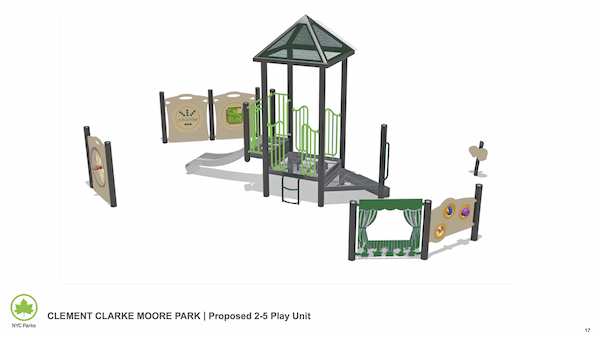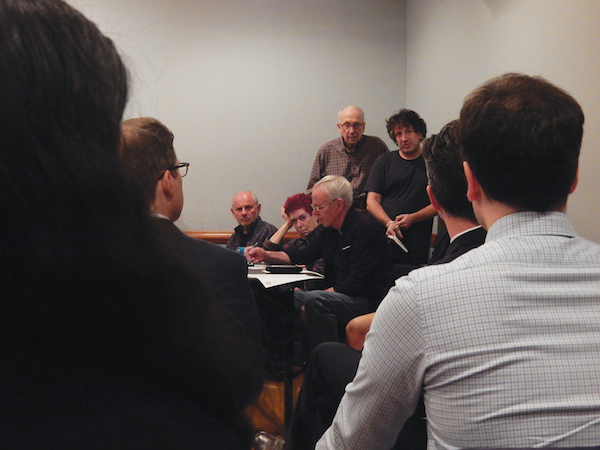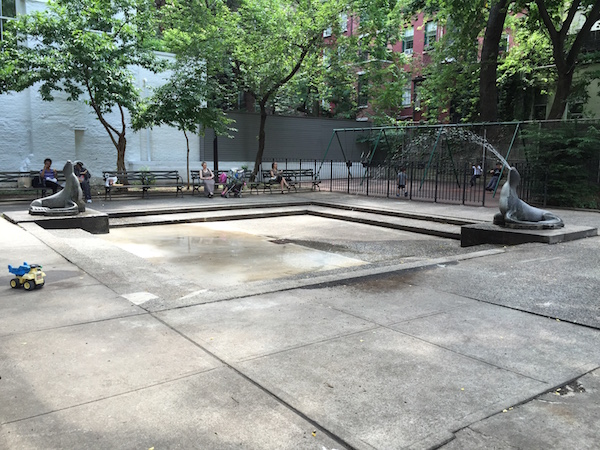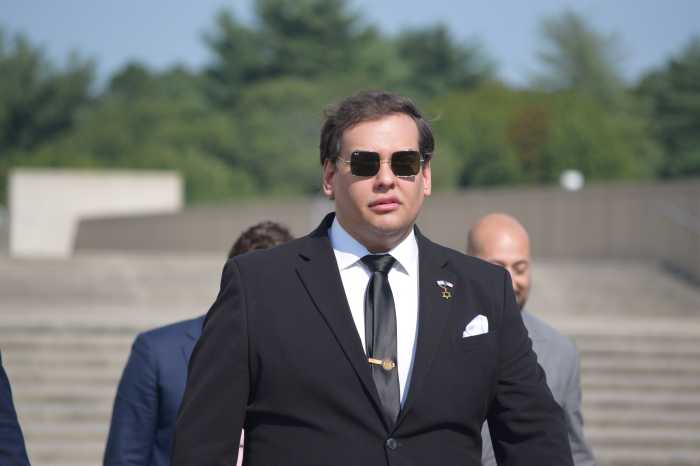
BY SEAN EGAN | The signature seal fountains will still be there to cool off frolicking kids — but an upgrade to Clement Clarke Moore Park means the popular destination (at 10th Ave., btw. W. 21st & W. 22nd Sts.) will have to close for at least a year.
Parents and concerned parkgoers greeted the news as necessary, if not entirely welcome, having been told about the closure during a presentation at last week’s Community Board 4 meeting of the Waterfront, Parks and Environment (WPE) committee.
The spirited dialogue was facilitated by Steve Simon, Manhattan Chief of Staff for the NYC Department of Parks and Recreation. He gave a brief introduction on the project’s background and development — specifically citing help from Allen Oster (a member of the WPE as well as the W. 400 Block Association, Oster is heavily involved with community outreach to gather ideas for the park). After Simon noted the support from City Councilmember Corey Johnson’s office for the park’s upgrade efforts, Tyler Parlato (also of Parks) began a PowerPoint presentation detailing the forthcoming changes.
Working on a budget of a little over a million dollars, the goals of the renovations are to reconstruct active spaces, maintain existing passive spaces, and integrate accessibility.
To the first point, the redesigned park would feature two new play units: one designed for children aged 2–5, and the other for 5–12-year-olds — as well as a small “playhouse” for very young children. In addition to the new play areas, a set of swings, larger than the current one and fenced in by a 3’6” steel panel fence, will be installed.

Parlato noted that while the new play areas are predominantly geared toward activities that demand upper body strength (such as monkey bars), they would also feature plenty of ground level structures, to “provide play opportunities for children with disabilities.” Other efforts include the installation of Americans With Disabilities Act-compliant (ADA) swings, an ADA ramp to the spray shower, and an ADA-compliant water fountain.
These new play areas would also feature recessed safety surfacing, a softer material to help prevent injuries — a definite improvement over the park’s current concrete. The rest of the concrete that currently comprises most of the park’s area is going to be replaced with decorative pavement, and new ’39 World’s Fair benches are to replace the old ones. Other general improvements include efforts to combat flooding, as well as shortening the seven-foot fence around the park’s perimeter to four feet (in accordance with the Parks Without Borders initiative, which tries to make parks more welcoming).
After the presentation, the room was open for questions and discussion, starting with the committee — which provided Simon with many insightful suggestions, based on firsthand use of the park.
Noting that “people use them all the time,” committee member Brad Pascarella asked what would happen to the picnic tables, and suggested arranging seating to allow for more interactions between parkgoers. Simon said the picnic table could be moved, and that benches could be added to facilitate conversation.

In addition, Pascarella brought up the fact that, currently, all the kids in the park run through the large planter on the north side of the fence (pretending it is a jungle), and thought something could be done there.
“At one point I was surprised there was any dirt left in the park, because my boys would come home with half of it,” noted WPE Co-Chair Lowell Kern.
Simon agreed that something could be worked out with the planter, in order to maintain, and improve, the current status quo. He and the committee postulated that perhaps a mulched trail within the area for kids to follow would be a worthy addition.
To the general agreement of the committee, J.D. Noland and Kern expressed trepidation about diminishing the height of the park’s fence. Others noted that it has kept the park safe and is not an eyesore like many other fences, due to its iron construction and relatively recent installation.
“With the preponderance of homeless issues we’ve had, a four foot fence gets climbed very easily,” Kern warned.
Bob Trentlyon, another member of the committee, was assured that only sick or dead trees would be removed from the park. The park’s two beloved “seal fountains” were also a topic of concern.
“You’re keeping the seals, right?” asked Pascarella playfully.
Simon confirmed that they would, indeed, stay put. “That’s our official seal,” he quipped. “There’s an amazing spirit about this park,” he continued. “I’ve never seen that anywhere else.”

He did, however, have to bear some bad news about the project’s progress, revealing that the whole endeavor would take approximately two years to complete — including a year spent going through the Landmarks Preservation Commission and finding contractors, followed by a year of construction. To the crowd’s audible dismay, Simon said that this would entail the park being closed for a year — and that doing it in segments, or getting it done quicker, seemed unlikely.
Beyond that, the public seemed quite enthusiastic about the upcoming renovation, though the “improvement” of shortening of the current seven-foot fence to around four-feet seemed to stick in their collective craw. Nearly everyone in attendance reiterated that while the Parks Without Borders initiative is a good idea, it would be better practiced in areas other than Chelsea, including a man who identified himself as a father of three, who voiced concerns of safety in the event of the fence’s shortening. In addition, another common suggestion was an even greater amount of the safety surfacing, though it was conceded that it might be impractical or cost-prohibitive to enact it.
The committee agreed to draft a letter incorporating some of their well-received suggestions to Parks. Before the meeting concluded, Kern asked Simon if he wouldn’t mind coming back soon.
“No, I will never come back here again,” Simon said with a laugh, before heartily agreeing to present again to the public on the park.
































